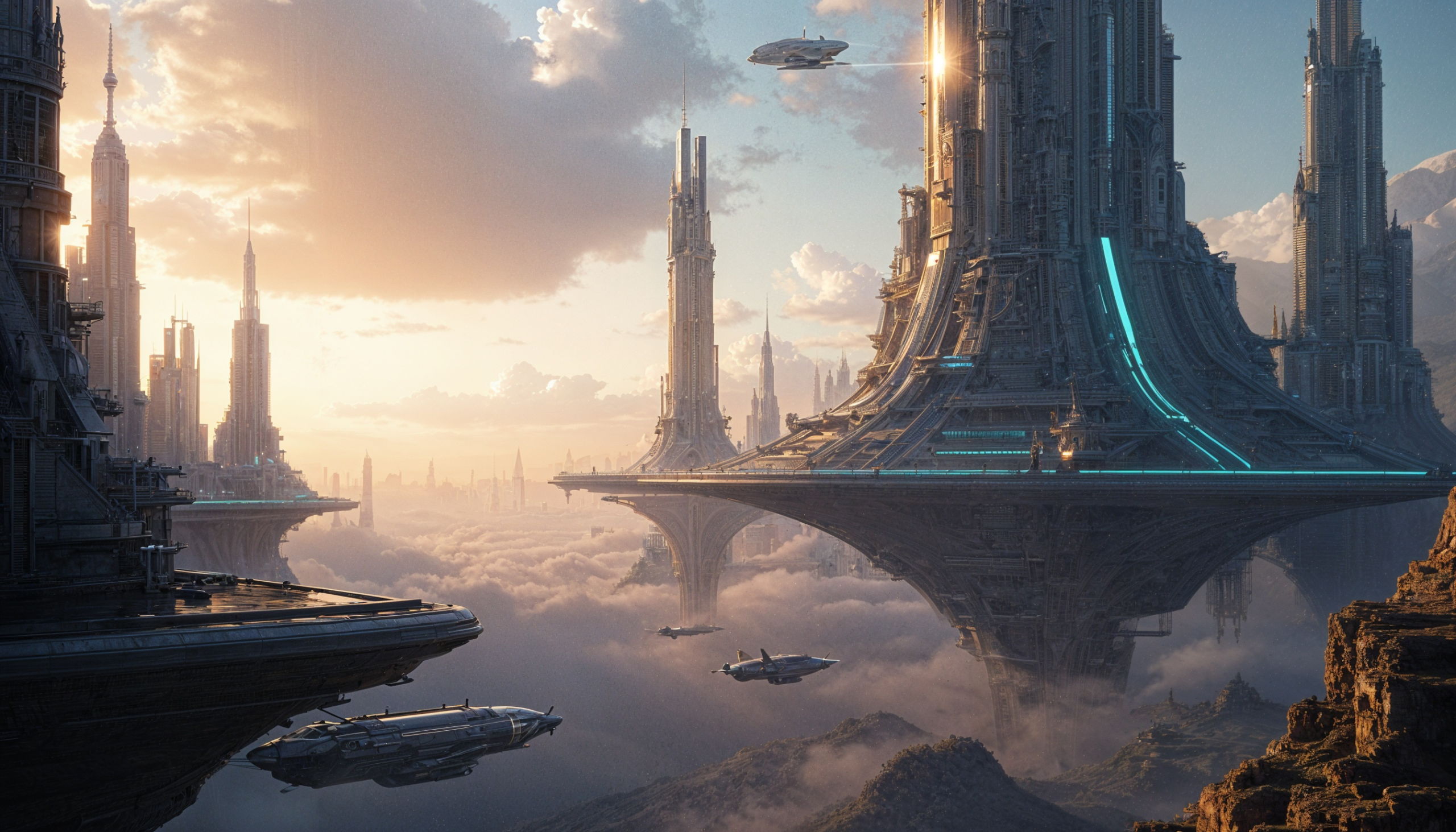In a far-off corner of the cosmos, there exists a civilization that has transcended the limitations of individual planets and even entire star systems. This civilization is classified as a Type III Civilization. Its power extends to manipulating the very fabric of galaxies, harnessing energies we, as a species on Earth, can barely comprehend. The essence of life here, among the stars, speaks to a narrative woven from threads of collective existence, interstellar artistry, and the profound depth of culture.
The beings inhabiting this galactic society—let's call them the Zhalari—live within radiant metropolitan constructions suspended in the vastness of space, inside colossal structures crafted from exotic materials unknown to Earth. These megastructures, commonly known as World Spires, spiral skywards in awe-inspiring geometries, each unique and full of cultural significance. With the ability to manipulate gravity, these spires float above the desolate void, serving as hubs for multi-species interactions.
The Zhalari’s culture is a tapestry sewn together over millennia, reflecting the influences of countless civilizations throughout history. They have inherited and redefined dimensions of art and philosophy that resonate with our own ancient cultures—mirroring the inspirational achievements of the Aztecs' grand temples, the harmonious blend of nature and spirit in ancient Japan, and the majestic storytelling of the great Persian poets. In this galactic world, artistry is not confined to traditional mediums; it transforms into experiences that blend sound, light, and consciousness. Vast public spaces boast holographic sculptures that tell stories too intricate to capture with mere words, drawing threads from ancient epics alongside new narratives crafted in real-time.
In daily life, individuals, among them artists, scholars, and engineers, embrace their roles in a symbiosis of purpose and passion. A painter in this civilization, for instance, utilizes luminous nano-pigments blending seamlessly with their surroundings, crafting visual landscapes that pulse with the shifting colors of nearby starfields. Education occurs within expansive, interconnected learning clusters, where knowledge flows freely among species and consciousnesses, transcending language barriers through an intuitive form of thought sharing. Think of a classroom where students draw directly from the collective wisdom of countless minds, swimming through a sea of thought like fish in a coral reef.
Transportation within the Zhalari civilization defies our notion of vehicles. Instead of metal machines, they navigate interstellar distances using thought-activated portals that connect to fixed points around galaxies. These gateways bend space and time, creating exciting highways of endless possibilities, where anyone can step through and arrive at their destination in seconds, whether that is a bustling market on a jovial moon or a tranquil resort orbiting a blue gas giant.
As a highly advanced civilization, the Zhalari have achieved what we might term post-biological evolution. They have redefined identity through their mastery of technology, integrating biological and synthetic forms into a single entity. Personal memories and experiences are stored in luminous crystal entities, reflecting a collective heritage. This allows individuals to access ancestral knowledge, soak in the wisdom of elders, and, perhaps most poignantly, feel the emotions of their predecessors. For the Zhalari, memories are not just personal but are part of a grander narrative that includes every member, past or present.
Yet, amid the beauty and sophistication, nuanced social structures underpin their society. Governance, for instance, embodies a complex system of shared leadership, known as the Confluence. This model draws inspiration from various historical societies—blending elements of democratic engagement with the fluidity characteristic of tribal councils. Leaders emerge from diverse backgrounds, engaging in a continuous dialogue aimed at shared goals, thus averting the rise of authoritarianism. This ensures that every voice echoes through the corridors of their vast civilization, shaping the future together.
While life in such a civilization seems idyllic, isolation remains a subtle thread woven into the fabric of existence. The vast distances between their interconnected spires can evoke a sense of loneliness. Despite the grand connections offered through shared experiences, each soul yearns for personal connection and understanding. Such is the paradox of advanced societies—though they have conquered the universe, they might discover that what they seek most is to truly know and be known by others.
In the 1000th century, the Zhalari face the ethical challenges of deep-space exploration. As they venture out into the far reaches of uncharted territories, they grapple with the responsibilities that come with understanding new civilizations they encounter. Their philosophers deliberate on the balance between exploration and the preservation of alien worlds, weighing the worth of knowledge against the sanctity of untouched experiences. In this manner, their ethics mirror our own ongoing debates, resisting the temptation to be merely conquerors and reaching instead for enlightened co-existence.
As they navigate their galactic landscape, the Zhalari ultimately shape their identity through the stories they tell—through art, governance, and even the acts of love that bind them. Each day, they rise among the stars, breathing in the beauty of their universe, forever evolving in companionship with one another, learning that despite all their advances, the most profound essence of life remains deeply rooted in the connections forged within a community.
In this bright future where wonder weaves through every layer of existence, the legacy of countless worlds composes a symphony of unity. It reminds us that though we gaze into the night sky and wonder about life beyond our own, the quest for understanding and companionship is a universal desire that transcends time and space. Through this hopeful examination of a Type III Civilization, we glimpse the potential of our own future—a canvas yet to be painted with the colors of our collective journey through the cosmos.
Disclaimer: This article may contain affiliate links. If you click on these links and make a purchase, we may receive a commission at no additional cost to you. Our recommendations and reviews are always independent and objective, aiming to provide you with the best information and resources.
Get Exclusive Stories, Photos, Art & Offers - Subscribe Today!
























Post Comment
You must be logged in to post a comment.